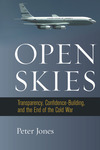 I recently read Peter Jones’ Open Skies: Transparency, Confidence-Building, and the End of the Cold War. Jones, who was part of the Canadian Department of External Affairs’ Verification Research Unit while the Open Skies treaty was being negotiated, offers an insider’s view of the process. The book’s subtitle, with its reference to “the End of the Cold War,” doesn’t capture just how quickly events overtook the planned treaty. What had begun as a US presidential initiative to test Soviet openness in 1989 was, by the time the treaty was signed in 1992, a multilateral European confidence-building measure. What had started as an alliance-to-alliance process (NATO to Warsaw Pact), had become a tool for defusing international tensions in East and Central Europe.
I recently read Peter Jones’ Open Skies: Transparency, Confidence-Building, and the End of the Cold War. Jones, who was part of the Canadian Department of External Affairs’ Verification Research Unit while the Open Skies treaty was being negotiated, offers an insider’s view of the process. The book’s subtitle, with its reference to “the End of the Cold War,” doesn’t capture just how quickly events overtook the planned treaty. What had begun as a US presidential initiative to test Soviet openness in 1989 was, by the time the treaty was signed in 1992, a multilateral European confidence-building measure. What had started as an alliance-to-alliance process (NATO to Warsaw Pact), had become a tool for defusing international tensions in East and Central Europe.
The basic principles behind Open Skies are the kind of thing that makes security-conscious intelligence officers blanch. Any signatory can, on about three days notice, fly a sensor-equipped airplane (carrying cameras with a resolution of no greater than 30 cm and synthetic aperture radar with a resolution of no greater than 3 m) anywhere over the territory of another signatory. Any signatory can then acquire the images from that flight, regardless of whether or not they were involved. The intrusiveness is the whole point behind the treaty as a “confidence-building measure,” since it signals that signatories have nothing to hide.
Perhaps unsurprisingly, intelligence communities on both sides of the Iron Curtain were lukewarm on the whole concept, since it was unclear how much it added to satellite reconnaissance in exchange for adding all sorts of security complications. So Jones’ narrative offers some very interesting explanations about why Open Skies was able to overcome that resistance.
Firstly, the signing of the Treaty of Conventional Armed Forces in Europe (CFE), meant that the Soviet Union (and, later, Russia), moved many of its forces east of the Urals. Since NATO powers other than the US had limited satellite assets, monitoring those troops required some sort of agreement. Open Skies fit the bill.
Secondly, the former Warsaw Pact powers had little or no interest in supporting Soviet or Russian security. Lacking much in the way of surveillance assets themselves, they too were interested in taking advantage of the possibility of cheap aerial observation. With border tensions coming out of the Cold War deep-freeze, confidence-building between former Pact members would also be valuable.
Lastly, though the Russians might have been assumed to be as wary as the US, or warier, they realized that the Soviet satellite reconnaissance system was unsustainable, and that they too would find a use for lower-cost surveillance opportunities.
 This last reason turns out, it seems, to be one of the most persistent facts about the Open Skies treaty. While the US continues to fly the same 1960s era airframe it put into service in the mid-1990s (the Boeing OC-135B Open Skies), as do most other signatories (many of the NATO powers share a pod that can be mounted on any countries C-130; most of the former Warsaw Pact countries fly Antonov An-30 survey aircraft), the Russian Federation invested in a pair of new Tu-214ON aircraft that first flew in 2011 and will probably be certified for Open Skies in 2016.
This last reason turns out, it seems, to be one of the most persistent facts about the Open Skies treaty. While the US continues to fly the same 1960s era airframe it put into service in the mid-1990s (the Boeing OC-135B Open Skies), as do most other signatories (many of the NATO powers share a pod that can be mounted on any countries C-130; most of the former Warsaw Pact countries fly Antonov An-30 survey aircraft), the Russian Federation invested in a pair of new Tu-214ON aircraft that first flew in 2011 and will probably be certified for Open Skies in 2016.
The current Russian–Ukrainian crisis, which intensified after Jones’ book went to press, probably constitutes the biggest challenge for Open Skies to date. For the first time, Open Skies signatories are on the brink of war with each other (or effectively at war, depending on one’s point of view). A cautiously optimistic article in the newsletter Trust & Verify summarizes how Open Skies monitoring continued to function through July 2014. The US was still overflying Russia in November (according to Stripes). The US Mission to the OSCE has a twitter feed (@marvindiana), which mentions the latest missions. It reports that Russia has rejected two Ukrainian Open Skies missions last month, but a US flight is supposed to be flying over eastern Russia tomorrow after engine trouble today (the OC-135B’s engines first flew in 1959 – these are an old design). We’ll have to keep watching #openskiestreaty to see how things go from here.
